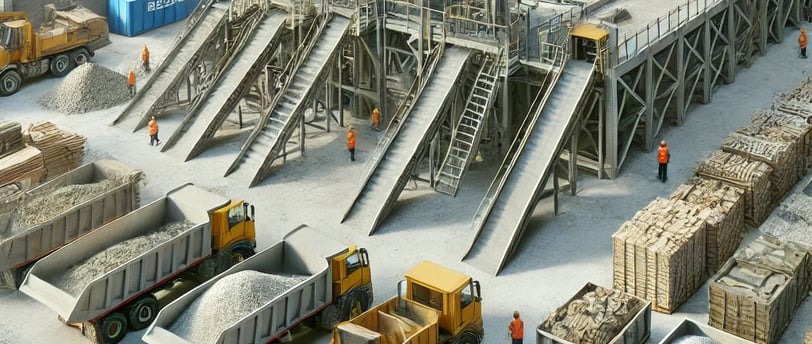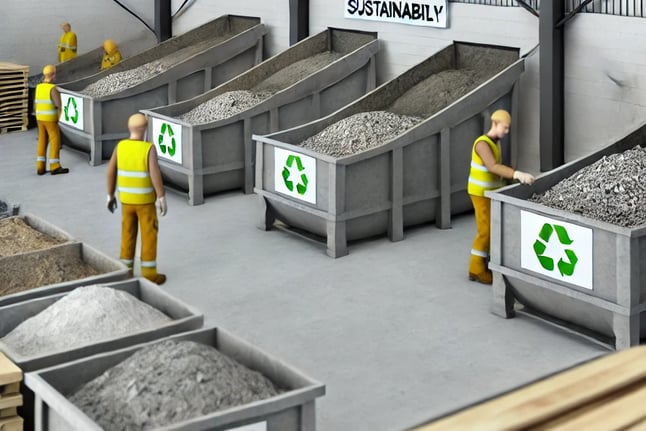Ol&LO, art elevated by MINERAL
Ecological Assessment of Construction Materials: Where Does Plaster Stand?
This article provides an ecological assessment of various construction materials, focusing on plaster. It compares the consumption, recyclability, and carbon impact of materials such as concrete, steel, ceramics, plastic, and wood. The article also explores plaster concrete in interior design and discusses economic constraints and cost analysis for different materials. The conclusion emphasizes the balance between environmental, economic, and functional aspects to determine the ideal material for sustainable construction.
LINKEDINACTUALITÉ
Olivier Houdusse
12/5/20244 min read


📈 Comparison of Annual Consumption and Recycling Rates for Different Construction Materials
The table above compares annual consumption and recycling capacities for major materials in France. Steel has an exemplary recyclability rate, close to 99%, whereas ceramics fall behind with only 10%. However, recyclability alone cannot be the only criterion for selecting materials: the carbon footprint over the life cycle must also be considered, especially for materials like concrete, whose production is energy-intensive. Plaster, with recycling prospects aiming for 30% by 2030, stands out due to a production process that requires less energy compared to concrete and steel.
Within the framework of a circular economy, the recycling potential and the integration of materials into new value chains are essential. Advances in recycling processes for plaster and concrete, for example, have enabled these materials to be valorized in new applications, enhancing their overall sustainability.




🔎 Material Details: Brief Analysis
1. Plaster
Annual Consumption: 8 million tonnes.
Recyclability: 21.4%, with initiatives targeting 30% by 2030. Plaster is lightweight and has significant reuse potential, particularly for producing construction boards and interior fittings.
Carbon Impact: Plaster production generates fewer CO₂ emissions than other materials like concrete or steel, and its recycling requires less energy.
2. Concrete
Annual Consumption: 50 million tonnes.
Recyclability: 66%, mainly used as aggregates for infrastructure. Concrete production is energy-intensive due to cement manufacturing, a key component.
Carbon Impact: Concrete accounts for about 8% of global CO₂ emissions. Approaches to reduce the impact include partially replacing cement with fly ash or other pozzolanic materials.
3. Ceramics
Annual Consumption: 1.2 million tonnes.
Recyclability: 10%. Waste is often used as backfill. The variability in ceramic compositions hampers their homogenization for recycling.
Carbon Impact: Ceramic production is energy-intensive due to the high temperatures required for firing.
4. Plastic
Annual Consumption: 3.6 million tonnes.
Recyclability: 42%, with considerable variability depending on polymer types. Sorting plastics remains a major challenge for achieving effective recycling.
Carbon Impact: Plastic production involves significant GHG emissions. Chemical recycling could enhance plastic durability, reducing reliance on fossil resources.
5. Steel
Annual Consumption: 14 million tonnes.
Recyclability: Nearly 99%. Steel retains its mechanical properties after recycling. Production from recycled materials is less energy-intensive compared to primary production.
Carbon Impact: Although steel recycling reduces GHG emissions, its initial production remains energy-intensive. Initiatives like hydrogen-based green steel aim to significantly reduce this carbon footprint.
6. Wood
Annual Consumption: 3 million tonnes.
Recyclability: 90%, widely used for making pallets and furniture. Wood is renewable, but chemical treatments can limit its reuse.
Carbon Impact: Wood acts as a carbon sink, storing CO₂ during its growth. Sustainable forest management practices are crucial to ensuring long-term durability.
Plaster Concrete: Design, Decoration, and Interior Fittings
Plaster concrete is a composite material combining the lightness of plaster with the robustness of concrete. It is highly valued in interior design, particularly for furniture, cladding, and countertops. Its modern aesthetic and soft finish make it an appealing alternative for decorative applications.
Compared to other materials like traditional concrete, plaster concrete stands out for its reduced carbon footprint and ease of implementation. It is also compatible with low-impact manufacturing strategies and non-toxic finishes suitable for indoor environments.
Comparison of Manufacturing a 100 kg Table
Let's analyze the cost, environmental impact, and complexity of manufacturing a 100 kg table using different materials:
Plaster: Lightweight and inexpensive (8-12 €/m²). Estimated cost: 20-30 €.
Concrete: Sturdy but heavy (50-80 €/m³). Estimated cost: 25-40 €.
Plaster Concrete: Aesthetic with a soft finish. Estimated cost: 35-50 €.
Wood: Durable material (70-120 €/m³). Estimated cost: 35-60 €.
Plastic: Cost varies depending on polymer (20-100 €/m²). Estimated cost: 40-100 €.
Ceramics: Aesthetic but fragile (20-50 €/m²). Estimated cost: 50-80 €.
Steel: Strong but costly (100-150 €/tonne). Estimated cost: 100-150 €.
Ranking of Materials by Estimated Cost for a 100 kg Table (in Ascending Order)
Plaster: 20-30 €
Concrete: 25-40 €
Plaster Concrete: 35-50 €
Wood: 35-60 €
Plastic: 40-100 €
Ceramics: 50-80 €
Steel: 100-150 €
This comparison highlights the differences in cost, practicality, and environmental impact, emphasizing the importance of selecting the right material based on specific needs and budget constraints. Plaster concrete presents a promising solution for projects seeking a balance between aesthetics, durability, and cost.
Economic Constraints and Utilization Costs
The economic constraints associated with the use of construction materials are just as significant as environmental considerations. Below is an analysis of average costs per m² and m³:
Concrete: 50-80 €/m³. Although inexpensive, it is energy-intensive, particularly in cement production.
Plaster: 8-12 €/m². Affordable, but recycling and waste management costs can be a challenge.
Steel: 1000-1500 €/tonne, or around 150-300 €/m². Steel is expensive but durable, and its recyclability makes it a potentially worthwhile investment.
Wood: 70-120 €/m³. Wood is economical, especially if sourced locally, though costs increase for specific species or required treatments.
Ceramics: 20-50 €/m². Ceramics are expensive to produce and install but offer durability in certain applications.
Plastic: 20-100 €/m² depending on the polymer type. Plastic is relatively affordable, but its environmental impact and limited recyclability are challenges to consider.
These costs underscore the importance of integrating financial considerations from the design phase to ensure the viability of material choices.
🌱 Conclusion: Which Material is Ideal?
The ideal material choice depends on a holistic evaluation of environmental, economic, and functional criteria. For projects aiming to minimize the carbon footprint, plaster is advantageous due to its low energy consumption. For optimal recyclability, steel is recommended due to its recycling rate approaching 99%. Wood, as a renewable resource, offers a sustainable solution, although necessary treatments may pose environmental challenges.
The goal for each project is to balance these criteria to foster a genuinely sustainable approach in the construction sector.
💬 How would you incorporate these recyclable materials into your projects? Your feedback is essential for more sustainable construction! 👇
#SustainableConstruction #Plaster #Recycling #CircularEconomy #EcoFriendlyMaterials




